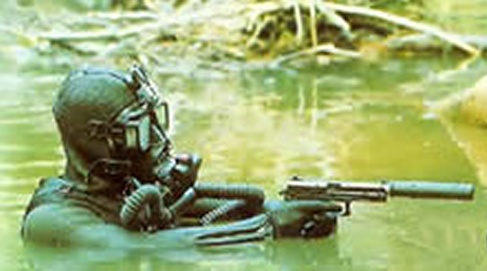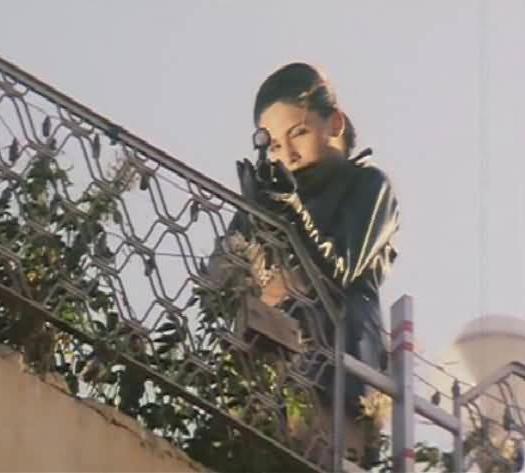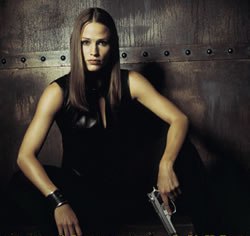LK Please help
|
Bronze Member Username: VbalashoOregon Washington Post Number: 66 Registered: Jun-06 | I got read off dish pro LNB's and installed (look like one cercule with two cables out) My 322 dish network reciever still working with new LNDS(cercule one), but Pansat still missing channels. How do you call this LNB......when you do set up on pansat????????? |
|
Silver Member Username: Jenifer_contrerasPIMP MemberYokosuka, Ka... Post Number: 515 Registered: Jul-06 | Hey Russian Soldat! This will be a one-time help!  Low Noise Block-downconvertor (so called because it converts a whole band or "block" of frequencies to a lower band).An LNB sits on the end of an arm and faces the parabolic reflector ("dish") which focusses the signals from a satellite 24,000 miles away into the "feed horn" of the LNB The LNB converts the signals to a lower frequency and sends them out to the satellite receiver via coaxial cable. ============================ List of LNB types: 1) Standard LNB 10.0 GHz L.O. Often called a "Marconi switching LNB". Works in one band. Noise Figure usually 1.0 dB or better but older "Blue cap" types can be much worse. Integral feed horn, usually with 40mm neck but flange type available to special order and other neck sizes have been made (especially 22.5mm). Marconi also made a "Bullet" shape LNB of this type that used a PTFE insert instead of a horn. Polarisation switching is controlled by dc voltage supplied by the receiver. 12.5v to 14.5v gives vertical and 15.5 to 18v gives horizontal polarisation. A higher voltage than that can damage the LNB. A voltage that is too low will prevent the LNB from working correctly. 2) "Enhanced" LNB 9.75 GHz L.O. The Cambridge "Juno" AE6 is an example of an "Enhanced" LNB, having a Local Oscillator of 9.750 GHz. Works 10.7-11.7 GHz. Noise Figure usually 1.0 dB or better. Integral feed horn with 40mm neck. Normally used with later type receivers that have a 2GHz tuner but no 22kHz signal generator. Designed specifically for Astra satellite reception from satellites 1A, 1B, 1C and 1D. Polarisation switching is controlled by dc voltage supplied by the receiver. 12.5v to 14.5v gives vertical and 15.5 to 18v gives horizontal polarisation. A higher voltage than that can damage the LNB. A voltage that is too low will prevent the LNB from working correctly. 3) "Universal" LNB 9.75 and 10.60 GHz L.O. The Cambridge "Platinum"Geo Universal G57" LNB Works in 2 bands* 10.7-11.8 and 11.6 - 12.7 GHz. (22 kHz signal switched). Noise Figure usually 1.0 dB or better. Integral feed horn with 40mm neck but flange type available to special order. *If your receiver tuning range is less than 2.15GHz you will have a gap between high and low bands. Refer to calculations, below. In effect, this is a "Quad Band" LNB. A Universal LNB requires a 22kHz signal at 0.5v p-p to switch its Local Oscillator to 10.6GHz ("high band"). Otherwise it uses its 9.75GHz oscillator. Polarisation switching is controlled by dc voltage supplied by the receiver. 12.5v to 14.5v gives vertical and 15.5 to 18v gives horizontal polarisation. A higher voltage than that can damage the LNB. A voltage that is too low will prevent the LNB from working correctly. "DBS" LNB 10.75 GHz L.O. Normally bolted to a separate polariser and feed horn. Works in one band: 11.7 - 12.5 GHz. Receiver with standard 0.95 - 1.75GHz tuner may be used. Noise figures vary. "Telecom" LNB 11.0 GHz L.O. Normally bolted to a separate polariser and feed horn. However, Marconi made a voltage-switching version with integral feed horn*. Works in one band: 11.95 - 12.75 GHz. Receiver with standard 0.95 - 1.75GHz tuner may be used. (* identified by a serial number label with a red corner, although some were incorrectly marked). Noise figures vary. "Dual band" LNB Normally bolted to a separate polariser and feed horn. Works in 2 bands 10.9 - 11.7 and 11.7 - 12.5 GHz. Receiver with standard 0.95 - 1.75GHz tuner may be used. Band switching achieved by supply voltage of either 14 volts or 18 volts. Noise figures vary. "Tripleband" LNB Normally bolted to a separate polariser and feed horn. Works in 2 bands 10.9-11.8 and 11.8-12.75 GHz. Receiver with 0.95 - 2.0 GHz tuner should be used. Noise figures vary. "Quadband" LNB Normally bolted to a separate polariser and feed horn. Works in 2 bands 10.7-11.8 and 11.7-12.8 GHz. Receiver with 0.95 - 2.05 GHz tuner should be used. Noise figures vary. "Twin-output" LNB Currently available in Standard, Enhanced and Universal form, the twin output LNB provides two outputs to feed two separate receivers. Each output can be switched by 13/17 volt input by the individual receiver to change polarisation. "Dual-output" LNB Was available in Standard and Enhanced form, the dual output LNB provided two outputs to feed two separate receivers. Each output had a fixed polarisation; one horizontal and one vertical. This type of LNB was used with switching boxes such as the "Mini Magic" which could feed four separate receivers. This type of (obsolete dual-output) LNB is no longer used in the UK and Europe, having been superseded by the "universal" type. Therefore a "mini magic" distribution system is no longer available. Instead, you should use a "quad-output" universal LNB or, if you need more than four outputs, a "quattro LNB" plus a (expensive) head-end distribution system which will usually feed up to at least 12 (sometimes 16) receivers. Note that a "twin-output" LNB is frequently (and incorrectly) called a "dual-output" LNB in the USA and sometimes even in the UK and Europe. Care should be taken when ordering! A "Dual LNB" usually refers to a "monobloc" or "monoblock". "Dual LNB" or "Monobloc LNB" Comprises two universal LNBs fixed together at a small angle in a single housing. Only one "F" connector is used. A single coaxial cable connects to the Digital (or Digital + Analogue) receiver which must be able to use DisEqC signalling to select which LNB is to be used. Normally used on an 80cm dish to receive Astra at 19.2'E and Hotbird at 13'E (but not simultaneously). monobloc setup monobloc setting up This type of LNB has a single output and the actual satellite signal is selected by the receiver which sends a DisEqC (22kHz) tone up the LNB cable. So only one satellite transmission can be viewed at a time. This is in contrast with dish systems that have two or more separate LNBs where, with two receivers, both satellite transmissions can be viewed or recorded simultaneously. See picture HERE. "Quad-output" or "Quad universal LNB" This can feed four separate receivers. Each receiver has independent control of polarisation and band via 13/17v switching and 22kHz o/off respectively. This LNB is used with the new Sky Digiboxes that have two LNB inputs and internal Hard Drives for recording a programme while you watch another. Two LNB outputs go to this "Sky Plus" Digibox and the other two LNB outputs can go either to two standard Digiboxes or to one other "Sky Plus" Digibox. "OCTO" LNB As above but with eight independent outputs. "Quattro universal LNB" This has four fixed outputs and is used only in "head end" I.F. distribution systems for apartment blocks. One LNB supplies a head end unit that can provide (typically) up to 16 outputs for separate Digiboxes. The four outputs of the LNB are as follows:- 1. Horizontal polarisation low band 2. Horizontal polarisation high band 3. Vertical polarisation low band 4. Vertical polarisation high band You should not connect any of the outputs, 1 - 4, directly to a receiver unless you want to restrict viewing to just one of the four options. Even if you do, the receiver may not work. It's not a good idea. Use the Quad instead. "DirecTV LNB" This is what the Americans confusingly call a "Dual Output DBS LNBF" and has a local oscillator frequency of 11.25 GHz. It is not compatible with UK systems and it's not available in the UK or Europe. I suspect that "dual output" is what we call "twin-output" but that makes me wonder what they call our "dual-output" LNB! Input Frequency - 12.2 to 12.7 GHz Output Frequency - 950 to 1450 MHz Noise Figure - 1.1 dB, Max Gain - 50 to 62 dB LO Frequency - 11.25 GHz, ± 2 MHz It is entirely different from LNBs used in the UK and Europe in that it has a single internal oscillator running at 11.25 GHz whereas our "universal" LNBs have two selectable oscillators running at 9.75 and 10.6 GHz respectively. -------------------------------------------------------------------------------- Is there actually a different LNB for prime focus dishes + offset dishes? Surely an LNB's innards are the same and the feedhorn or the C120 flange is the only difference? In the old days, LNB noise figures were high, the gain (amplification) was low and satellite transponder power was typically 20 Watts. Imagine trying to see a 20 Watt light bulb 24,000 miles away! (You'd have trouble seeing a 20W bulb at the end of a 24 yard corridor). So, an LNB and feedhorn had to be matched to the dish. The open end of the feed horn LNB had to be at the exact focal point of the dish and the horn had to be flared in such a way that, with it at the focal point, the horn could "see" the exact circular area of the dish - no more and no less. If it was less then it wasn't collecting signal from the full area of the dish. If it was more, it was also collecting unwanted "noise" from any warm object (wall) or from the sky behind the dish. A good compromise was to take just part of a much larger paraboloid dish and mount the LNB in an "offset" position. The curvature of this partial dish is such that the focal point is now much lower so the LNB and feedhorn no longer obscure the signal path as they would with a "prime focus" dish. Nowadays, satellite transponders can produce typically 50 or 60 Watts and LNBs have higher gain and lower noise figures. With these strong transmissions, you can get away with murder. People stick any old thing on the end of the boom arm - which rather explains why one man's 0.6dB LNB is another man's nightmare when the signal strength is not optimum! The Sky minidish, for example, is a compromise between size and performance. It's very important that the LNB matches the dish exactly. This is one good reason why the dish comes with its own LNB. The manufacturers might "fudge" the issue if asked. After all, if they admit that their LNB works best with, say, an 80cm Lenson Heath dish and you just bought an 1 metre dish made by someone else, you might not be too happy. If you "mix 'n' match" by picking a 60cm dish and a Universal LNB at random, the chances are that the performance could be no better than that of the Sky minidish. As a general rule, any standard LNB will work with a circular (prime focus) dish or an offset focus dish which is taller than it is wide (which "looks" circular when viewed by the LNB). However, a dish which is wider than it is tall will need a special LNB. |
|
Bronze Member Username: CrippledwarcookPost Number: 71 Registered: Apr-06 | what a fcuking waste of bandwidth....who fcuking cares about all that mumble jumbo...first warning to you Jennifer, you stupid fcuking broad..next time you will be banned?..ROTF |
|
Silver Member Username: Jenifer_contrerasPIMP MemberYokosuka, Ka... Post Number: 519 Registered: Jul-06 |  |
|
Silver Member Username: Jenifer_contrerasPIMP MemberYokosuka, Ka... Post Number: 520 Registered: Jul-06 |  |
|
Silver Member Username: Jenifer_contrerasPIMP MemberYokosuka, Ka... Post Number: 521 Registered: Jul-06 |  |
|
Silver Member Username: Minn_rockPost Number: 583 Registered: Aug-06 | JENIFER CONTRERAS WHAT A LIPS..GOOD ENOUGHT TO??U KNOW WHAT I MEAN..HAHA... |
|
Silver Member Username: Jenifer_contrerasPIMP MemberYokosuka, Ka... Post Number: 523 Registered: Jul-06 | Hey Minn..!.  |
|
Silver Member Username: Minn_rockPost Number: 584 Registered: Aug-06 | LOL. WHAT I SAID??AND WHAT WITH THE GUN POINTING??I AM TALKING TO THE CAN OF SODA..LOL WOMEN!! |
|
Silver Member Username: Jenifer_contrerasPIMP MemberYokosuka, Ka... Post Number: 525 Registered: Jul-06 | no...no...no for this:https://www.ecoustics.com/electronics/forum/home-video/284224.html |
|
Silver Member Username: Minn_rockPost Number: 586 Registered: Aug-06 | Jen do not worry just stay right where u at..wait until i am finish with her and getting bored with her,and when she have no more use for me and i will come to u..just wait it don't take long..no kidding..hehe.. |
|
Silver Member Username: Jenifer_contrerasPIMP MemberYokosuka, Ka... Post Number: 528 Registered: Jul-06 |  Dear Minn,drop her right away and come to me! I got the money (a lot),a very good work (at military naval base)! I have Two houses( one here in USA and another one in Colombia),next year I wanna to buy in Costa-Rica,then, three cars (bmw x5,bmw m6 and nissan maxima)...two dishes(K band and C band),10 LNB,two pansats,one VSextr.,Dn receiver and two Direc Tv receivers.47 Guns. Maybe 300 pair shoes...and another sh!t, BUT I Have no MEN!!! And you seems to me a very good recruit...So think about! |
|
Silver Member Username: Minn_rockPost Number: 588 Registered: Aug-06 | LOL.. if u just stop holding gun or pointing your gun at MEN and u might get some MEN..now you r scaring the sh1t out of this MEN too.. |
|
Silver Member Username: GrimreeperPost Number: 233 Registered: Feb-06 | hell with all those toys thro in a sweet street bike and atv and ill sign up and be your boytoy LOL |
|
Bronze Member Username: VbalashoOregon Washington Post Number: 67 Registered: Jun-06 | Ok, I just came back to my internet. I thought that forums are helping to all of us. But now it does look like that we are going back to 06/2006-09/2006. Jen, I did not understand a word in you answer., Thank's. Also you are right, I was a soldat(Russian special forcies "Spedz. Naz", second luetenant)in Afganistan. Enough about it, I just asked for help. Thank's |
|
Silver Member Username: Crazy_greekPost Number: 137 Registered: Jul-06 | Hey vad How can you expect someone to help you when they don't understand you? Have someone help you to post your question and Iam sure someone here will be glad to help you. |
Main Forums
Today's Posts- Home Audio Forum
- Home Video Forum
- Home Theater Forum
- Car Audio Forum
- Accessories Forum
- All Forum Topics